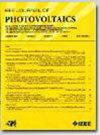热ald沉积氧化铪膜的高质量硅表面钝化
IF 2.5
3区 工程技术
Q3 ENERGY & FUELS
引用次数: 0
摘要
通过在硅表面(n型和p型)上原子层沉积(ALD)生长的氧化铪(HfOx)薄膜,实现了优异的硅表面钝化。从研究中可以推断,HfOx薄膜的硅表面钝化是与薄膜厚度有关的质量,最小膜厚度为~ 2 nm是钝化硅表面所必需的。当膜厚d >5 nm时,表面钝化效果良好(表面复合速度SRV< 20 cm/s)。然而,在氢退火的~ 8.5 nm薄HfOx薄膜中获得了最好的结果。在p型和n型硅表面上分别实现了低至3.5 cm/s(有效少数载流子寿命τeff ~ 5 ms)和4.4 cm/s (τeff ~ 4 ms)的SRV。τeff的注入水平依赖性表明,在低注入水平下,HfOx膜对n型硅的钝化效果优于p型硅。退火环境中存在的氢首先使薄膜/硅界面的悬空键饱和,然后影响氧化物的电荷密度。HfOx/n-Si样品的有效氧化物电荷密度为正,HfOx/p-Si样品的有效氧化物电荷密度为负。这为两种衬底类型的情况在硅表面附近创造了积累条件,并负责两种衬底的有效钝化。因此,我们的研究表明,ald生长的HfOx薄膜为硅表面提供了出色的钝化效果。本文章由计算机程序翻译,如有差异,请以英文原文为准。
High-Quality Silicon Surface Passivation by Thermal-ALD Deposited Hafnium Oxide Films
Excellent silicon surface passivation is achieved by atomic layer deposition (ALD) grown hafnium oxide (HfO
x
) films on silicon surfaces (both n-type and p-type). It is inferred from the study that the silicon surface passivation by HfO
x
thin films is a film-thickness-dependent quality and a minimum film thickness of ∼2 nm is essential to passivate the silicon surface. A good level of surface passivation (surface recombination velocity, SRV< 20 cm/s) can be achieved for film thickness,
d
>5 nm. However, the best results are obtained for hydrogen-annealed, ∼8.5-nm-thin HfO
x
films. SRV as low as 3.5 cm/s (effective minority carrier lifetime, τ
eff
∼5 ms) and 4.4 cm/s (τ
eff
∼4 ms) are realized on p-type and n-type silicon surfaces, respectively. The injection level dependence of τ
eff
reveals that HfO
x
films provide better passivation for n-type silicon compared to p-type silicon at low injection levels. Hydrogen present in the annealing ambient first saturates the dangling bonds at the film/silicon interface and then affects the oxide charge density. Effective oxide charge density is positive in HfO
x
/n-Si samples and negative in HfO
x
/p-Si samples. This creates an accumulation condition near the silicon surface for both substrate-type situations and is responsible for effective passivation in both types of substrates. Thus, our study demonstrates that ALD-grown HfO
x
films offer excellent passivation for silicon surfaces.
求助全文
通过发布文献求助,成功后即可免费获取论文全文。
去求助
来源期刊

IEEE Journal of Photovoltaics
ENERGY & FUELS-MATERIALS SCIENCE, MULTIDISCIPLINARY
CiteScore
7.00
自引率
10.00%
发文量
206
期刊介绍:
The IEEE Journal of Photovoltaics is a peer-reviewed, archival publication reporting original and significant research results that advance the field of photovoltaics (PV). The PV field is diverse in its science base ranging from semiconductor and PV device physics to optics and the materials sciences. The journal publishes articles that connect this science base to PV science and technology. The intent is to publish original research results that are of primary interest to the photovoltaic specialist. The scope of the IEEE J. Photovoltaics incorporates: fundamentals and new concepts of PV conversion, including those based on nanostructured materials, low-dimensional physics, multiple charge generation, up/down converters, thermophotovoltaics, hot-carrier effects, plasmonics, metamorphic materials, luminescent concentrators, and rectennas; Si-based PV, including new cell designs, crystalline and non-crystalline Si, passivation, characterization and Si crystal growth; polycrystalline, amorphous and crystalline thin-film solar cell materials, including PV structures and solar cells based on II-VI, chalcopyrite, Si and other thin film absorbers; III-V PV materials, heterostructures, multijunction devices and concentrator PV; optics for light trapping, reflection control and concentration; organic PV including polymer, hybrid and dye sensitized solar cells; space PV including cell materials and PV devices, defects and reliability, environmental effects and protective materials; PV modeling and characterization methods; and other aspects of PV, including modules, power conditioning, inverters, balance-of-systems components, monitoring, analyses and simulations, and supporting PV module standards and measurements. Tutorial and review papers on these subjects are also published and occasionally special issues are published to treat particular areas in more depth and breadth.
 求助内容:
求助内容: 应助结果提醒方式:
应助结果提醒方式:


